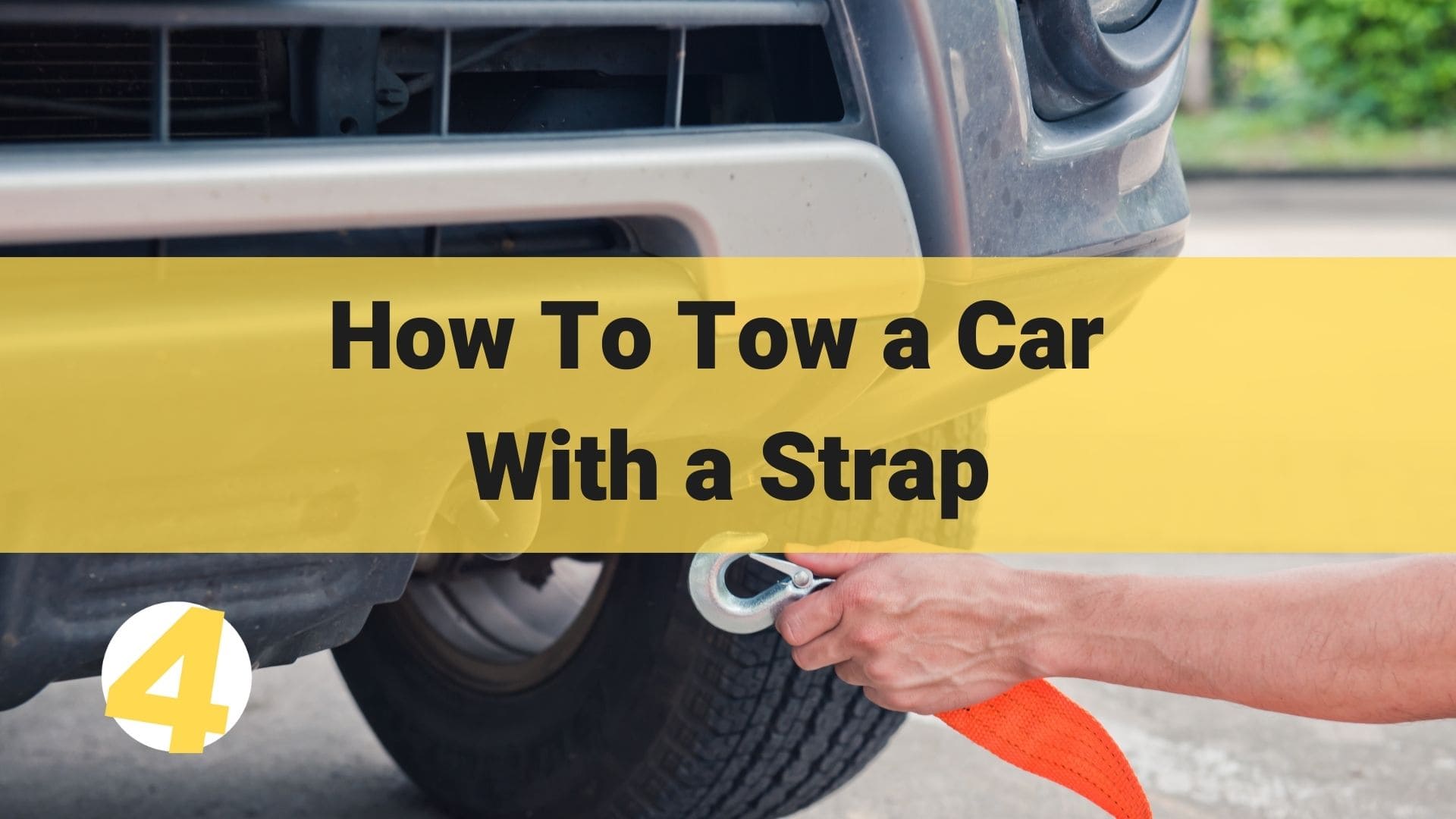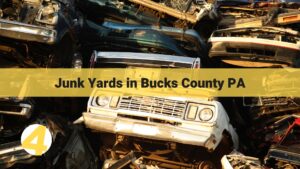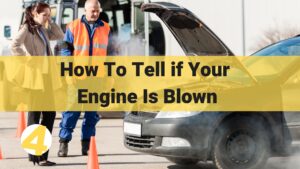Towing a car with a strap is a practical skill that can come in handy, whether you’re assisting a stranded vehicle or moving a car with mechanical issues. This article will guide you through the essential steps of how to tow a car with a strap safely and effectively.
From selecting the right equipment to understanding the legal requirements and safety protocols, we’ll cover everything you need to know.
What to Do: An Overview
Using a tow strap to move a vehicle requires careful preparation and attention to safety.
Here’s a structured approach to ensure a safe and effective towing process:
Legal Check
Before using a tow strap, verify it’s legal in your area. Tow straps are less safe for towing and may be restricted by local laws. It’s advisable to use tow straps only for short distances or in off-road situations.

Prepare the Tow Rope
Lay the tow rope flat on the ground in front of the vehicle to be towed. Make sure it’s free of knots or tangles. This step helps in correctly positioning the tow vehicle.
Rope Inspection
Examine the tow rope for any signs of wear, tear, or fraying. Using a damaged rope can be hazardous. Replace it if necessary.
Identifying Recovery Points
Locate the designated recovery points on the frames of both the towing and the towed vehicles. These are often marked in the vehicle’s manual and are essential for secure attachment.
Attaching the Strap
Thread the tow strap through the recovery point of the broken-down vehicle. If the strap has a hook, attach it back onto the strap; if it’s a loop, thread the strap through it to secure.
Aligning Vehicles
Position the towing vehicle in line with the towed vehicle, ensuring the strap is taut but not overly tight.
Securing the Tow Vehicle
Attach the strap to the towing vehicle’s rear recovery point or a suitable tow hitch. Avoid using a metal hook directly on the vehicle.
Tightening the Strap
Slowly drive the towing vehicle forward to tighten the strap. Observe for any damage or fraying.
Safety Precaution
Place a jacket or blanket over the tow strap. This can reduce the risk of injury if the strap snaps.
Towing Process
Tow the broken-down vehicle at a slow speed. The driver of the towed vehicle should keep it in neutral and use the brakes to manage distance.
Remember, this method is not suitable for long-distance towing. For longer journeys, consider using a dolly or a trailer. Always disconnect the tow straps once the towing is complete. Safety should be your top priority during the entire process.
Understanding the Basics of Towing Straps
Towing a vehicle with a strap requires a clear understanding of the types of straps available, their specific uses, and how to select the right one for your vehicle. It’s also crucial to check the strap’s load capacity and its condition to ensure a safe towing process.
Types of Towing Straps
Nylon Straps
These straps are known for their elasticity, which can be beneficial in certain towing situations. The stretchiness of nylon allows for a bit of a ‘snap’ effect, which can help in pulling a vehicle out of a stuck position. However, this elasticity also means that nylon straps can store kinetic energy, potentially leading to dangerous snap-back if they break under tension.
Polyester Straps
Unlike nylon, polyester straps have minimal stretch, making them more stable and predictable for towing on roads. They are preferred for situations where controlled towing is necessary, as they provide a steady pull without the risk of a snap-back effect.
Recovery Straps
Often confused with tow straps, recovery straps are specifically designed for recovering stuck vehicles, typically off-road. They are generally made of nylon to utilize its elastic properties, which helps in generating the force required to pull a vehicle out of mud, sand, or snow. It’s important to differentiate these from regular tow straps as their usage and capabilities vary significantly.
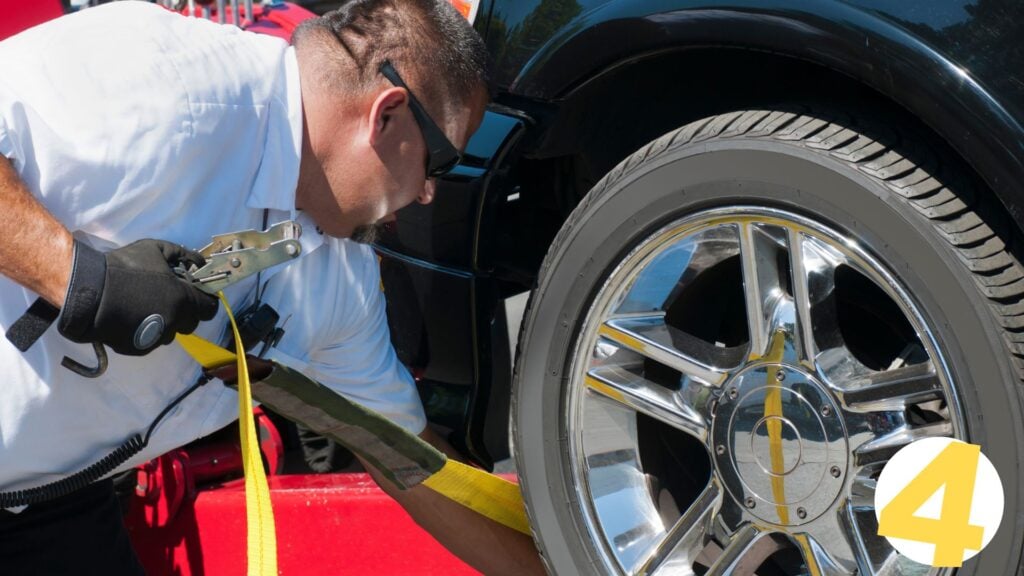
Choosing the Right Towing Strap for Your Vehicle
Selecting the appropriate strap for towing depends on several factors:
- Vehicle Weight and Size: Ensure the strap’s strength and length are adequate for the size and weight of the vehicle being towed.
- Towing Situation: Consider the type of towing required. For highway towing, a polyester strap is preferable due to its stability. For off-road recovery, a nylon recovery strap is more suitable.
- Compatibility with Vehicles: Check that the strap’s end fittings are compatible with the towing points on both the towing and towed vehicles.
Checking the Strap’s Load Capacity and Condition
Load Capacity
Every towing strap comes with a specified load capacity, often marked as ‘Breaking Strength’ and ‘Working Load Limit’. The Breaking Strength is the maximum force the strap can withstand before failing, while the Working Load Limit is typically a third of the breaking strength and is the maximum safe working load. Always use a strap with a capacity exceeding the total weight of the vehicle being towed.
Strap Condition
Regularly inspect your tow strap for signs of wear, tear, or damage. Look out for frayed edges, cuts, or significant fading, as these are indicators that the strap may not hold up under stress. Never use a damaged strap, as it poses a significant safety risk.
Age and Usage History
Consider the age of the strap and how often it’s been used. Materials can degrade over time, especially if frequently exposed to sunlight or harsh weather conditions. Regular use, especially in demanding conditions, can also weaken a strap.
Essential Equipment and Tools for Towing with a Strap
When preparing to tow a vehicle using a strap, having the right equipment and tools is crucial for ensuring safety and effectiveness.
Here’s a breakdown of the essential items needed:
Tow Hooks
These are strong metal hooks designed for towing and are usually attached to the chassis of a vehicle. They provide a secure point to attach tow straps or chains. It’s important to ensure that your vehicle’s tow hooks are in good condition and properly mounted.
Attachment Points
Apart from tow hooks, some vehicles have designated attachment points for towing. These are often reinforced areas on the vehicle’s frame. Always use these points for towing to avoid damage to your vehicle.
D-Rings
D-Rings are metal rings in the shape of a ‘D’ and are used as a connecting link between the tow strap and the vehicle’s attachment point. They must be of high strength to withstand the towing forces.
Shackles
Shackles are used to securely connect the tow strap to the vehicle, particularly if the strap doesn’t directly fit the tow hooks or points. Ensure the shackles are rated for the weight of the vehicle and are in good condition.
Tow Bar
A tow bar is a solid, rigid beam that connects two vehicles for towing. It’s a more stable option for towing over longer distances but less versatile than a tow strap.
Tow Strap
A tow strap is a flexible strap used for towing vehicles. It’s crucial to choose a strap with the appropriate strength and length for your vehicle and to ensure it’s in good condition.
Safety Chains
Safety chains provide an additional safety layer in case the primary towing connection fails. They should be strong enough to hold the towed vehicle’s weight and should be properly attached to both vehicles.
Preparing the Vehicles for Towing
Proper preparation of both the towing and towed vehicles is essential for a safe and effective towing operation.
Here’s how to ensure both vehicles are ready:
Properly Positioning the Towed Vehicle
- Aligning the Vehicles: Position the towed vehicle so that it aligns straight with the towing vehicle. This alignment is crucial to prevent the strap from dragging on the ground or getting caught during towing.
- Setting the Parking Brake: Initially, engage the parking brake of the towed vehicle to avoid any unwanted movement while setting up the tow strap.
- Neutral Gear: Ensure the transmission of the towed vehicle is in neutral. This allows the vehicle to roll freely without causing damage to the transmission system.
- Steering Lock: If the towed vehicle has a steering lock, make sure it is disengaged. This allows the wheels to turn freely, following the towing vehicle’s path.
Securing the Towing Vehicle
- Park on Level Ground: Start by parking the towing vehicle on level ground to provide a stable base for towing.
- Engage Parking Brake: Before attaching the tow strap, engage the parking brake of the towing vehicle to prevent it from rolling.
- Check Towing Capacity: Ensure the towing vehicle is capable of towing the weight of the towed vehicle. This includes checking the vehicle’s towing capacity and the strength of the towing hitch or attachment point.
Connecting the Towing Strap
- Attach to Designated Points: Attach the tow strap to the designated towing points or tow hooks of both vehicles. Avoid attaching the strap to parts of the vehicle that are not designed for towing, such as bumpers or axles.
- Use D-Rings or Shackles: If needed, use D-rings or shackles to secure the tow strap to the vehicles.
- No Slack in the Strap: Make sure there is no excess slack in the tow strap once it is attached. However, avoid over-tightening, as a little bit of play is necessary.
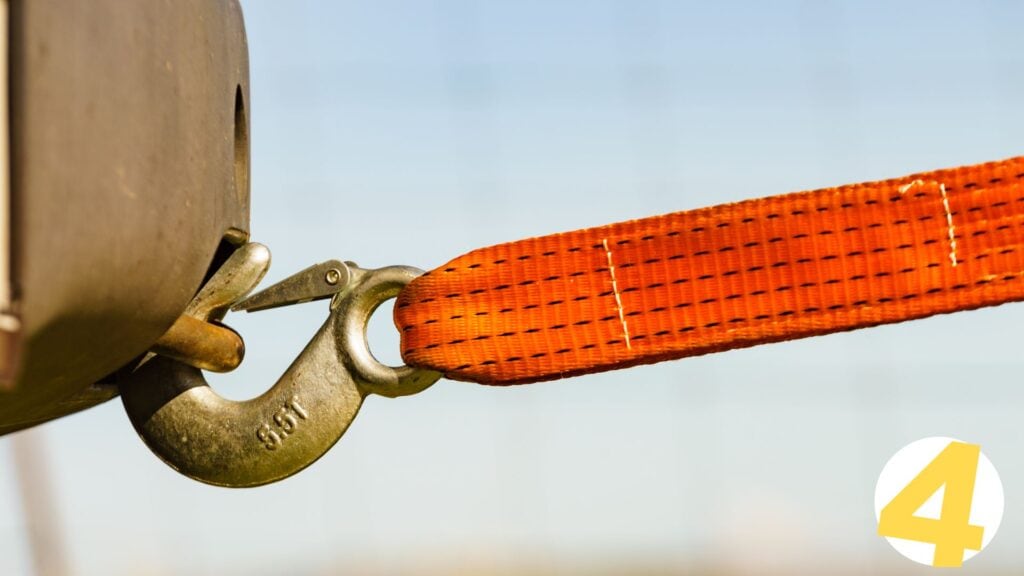
Ensuring Proper Visibility and Signaling
- Turn on Hazard Lights: Both vehicles should have their hazard lights on to alert other drivers that a towing process is underway.
- Use Towing Signage: If available, use a “Tow” sign on the back of the towed vehicle for additional visibility.
- Clear Windows and Mirrors: Ensure all mirrors and windows are clear for visibility. The driver of the towing vehicle needs to have a good view of the towed vehicle at all times.
- Communication Plan: Establish a way to communicate between the two vehicles, especially in case of an emergency or if the towed vehicle needs to signal the towing vehicle to stop.
Towing Techniques
Towing a vehicle using a strap requires specific techniques to ensure safety and prevent accidents.
Here’s a guide to effective towing practices:
Slow and Steady Wins the Race
Maintain a slow, steady speed while towing. High speeds increase the risk of accidents and put more strain on the tow strap. Avoid sudden speed changes. A consistent pace helps in maintaining control and reduces the chances of the tow strap snapping.
Smooth Acceleration and Braking
Gradually increase speed to avoid jerking motions which can stress the tow strap and the vehicles’ towing points. Apply brakes gently and well in advance. Sudden braking can lead to collisions between the two vehicles and can also damage the towing equipment.
Communicating with Hand Signals
Establish hand signals for basic commands like stop, slow down, or turn. This is crucial, especially if the towed vehicle’s brake lights are not functional. Signal Consistently: The driver in the towed vehicle should use the agreed hand signals to communicate with the towing vehicle, ensuring a coordinated towing process.
Maintaining a Safe Following Distance
Keep a sufficient distance between the towing and towed vehicles to allow room for braking and reacting to traffic conditions. In heavier traffic, increase the following distance to account for the unpredictability of other drivers.
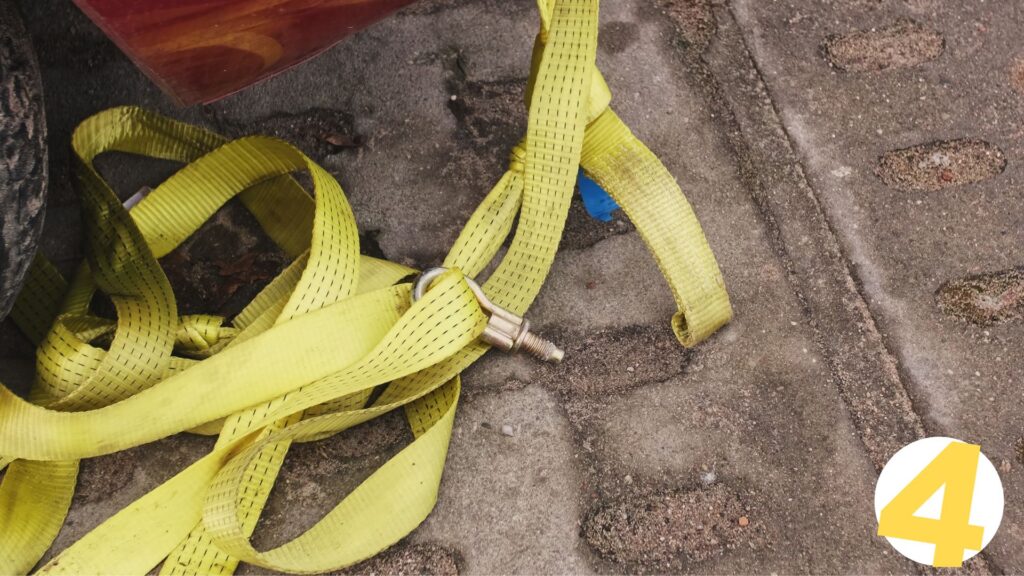
Dealing with Hills and Inclines
When towing uphill, maintain a steady pace to avoid putting excess strain on the tow strap and vehicles. Reduce speed when going downhill and ensure the towed vehicle’s driver is ready to use brakes to control descent speed.
On inclines, be cautious of the towed vehicle rolling back. Use the parking brake to control the vehicle’s position before moving. In manual transmission vehicles, use lower gears to maintain control on steep inclines or declines.
Towing with a strap requires careful attention to these techniques. It’s about balancing control and communication to ensure a smooth and safe towing experience. Always prioritize safety for both drivers and vehicles involved, and be prepared to adjust your techniques according to the specific towing conditions.
After-Towing Care
Once you have successfully towed a vehicle, it’s essential to follow proper procedures to safely disconnect the towing strap and inspect all equipment. This ensures everything remains in good condition for future use and addresses any issues that may have arisen during the towing process.
Safely Disconnecting the Towing Strap
Park both vehicles in a safe, flat area away from traffic to disconnect the strap. Before unhooking, ensure there’s no tension in the tow strap. If necessary, slightly adjust the position of the vehicles to relieve any strain on the strap.
Unhook the strap from the towed vehicle first, then from the towing vehicle. Avoid letting hooks or straps snap back violently. Once disconnected, neatly roll up the tow strap for storage. This prevents tangling and makes it easier to use next time.
Inspecting All Equipment for Wear and Tear
Check the tow strap. Look for any new signs of wear, such as fraying, cuts, or excessive stretching. If you find damage, replace the strap. Examine D-rings, shackles, and hooks for any bends, cracks, or deformities. Also, check for any signs of wear in the attachment points on the vehicles.
If the strap or other equipment got dirty, clean them before storage. Dirt and grime can hide damage and cause equipment to deteriorate faster.
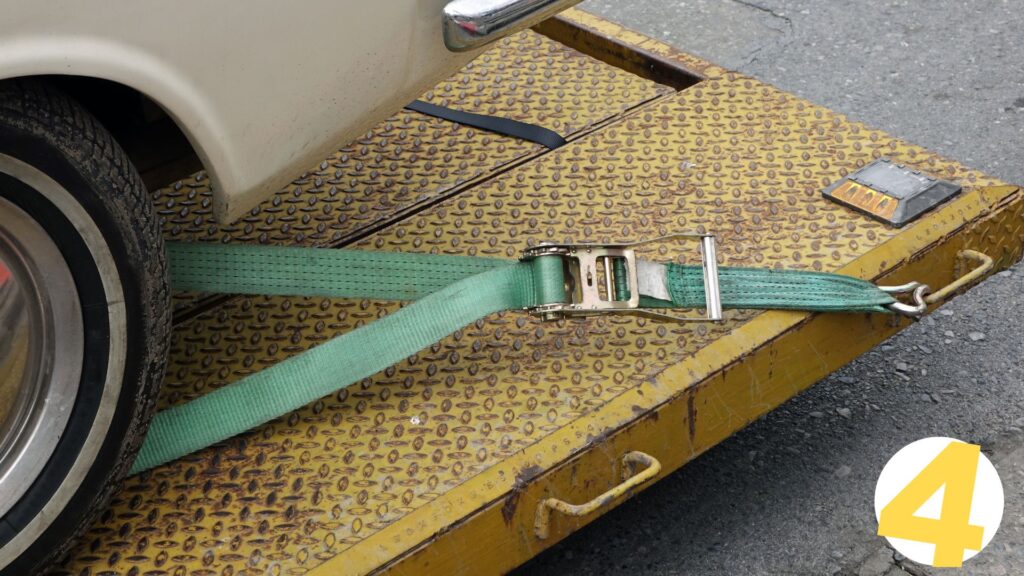
Cash4Cars: The Best Solution for Junking a Car
Towing a car with a strap is a practical skill that requires understanding the right equipment, proper vehicle preparation, and effective towing techniques. By choosing the correct towing strap, ensuring all equipment is in good condition, and following safe towing practices, you can efficiently tow a vehicle. Remember to always prioritize safety by inspecting your equipment, adhering to legal regulations, and maintaining clear communication between the drivers.
However, if you find yourself in a situation where your car is no longer functional and towing becomes a necessity more than an option, and you’re in the Philadelphia area, consider reaching out to Cash4Cars.
Cash4Cars offers an efficient, rewarding, and hassle-free solution for selling your car, regardless of its make, model, or condition. We are dedicated to providing a streamlined service that includes free pickup, which saves you the stress and complexities of arranging transportation. Serving Philadelphia and its surrounding areas, we provide cash for junk cars, while making sure we deliver a convenient experience for all our clients.
Our goal is to offer you top dollar for your old, damaged, or non-running vehicle while delivering exceptional customer service. Our experienced team will come directly to you, providing the convenience and speed needed to sell your car swiftly and effectively. For an easy and straightforward way to junk your car, call Cash4Cars now and make the process of moving on from your old vehicle as smooth as possible.

